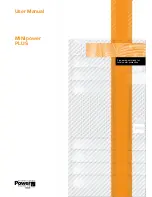
WARNING:
Risk of Electrical Shock. Hazardous live parts inside
these power supplies are energized from the battery even when the
AC input is disconnected.
AVERTISSEMENT!
Risque de choc électrique. Les parties actives danger-
euses à l'intérieur de ces blocs d'alimentation sont sous tension à partir
de la batterie, même lorsque l'alimentation c.a. est coupée.
CAUTION!
DO NOT USE THE MOUNTING BRACKETS TO LIFT
THE UPS.
The mounting brackets are
ONLY
for securing the UPS to
the rack.
ATTENTION! N'UTILISEZ JAMAIS LES SUPPORTS DE MONTAGE
POUR SOULEVER L'ONDULEUR.
Ces supports sont
uniquement
conçus pour fixer l'onduleur au rack.
NOTE:
These UPSs are shipped with the batteries disconnected. The
batteries must be connected before putting these UPSs into service.
Refer to Section 3 "Installation" for connecting the batteries.
To de-energize the outputs of the UPS:
1. If the UPS is on, press and release the On/Off/Test button during the
audible alarm's first beep to turn the UPS off.
2. Disconnect the UPS from the AC wall outlet.
3. To de-energize the UPS completely, disconnect the battery.
ON / OFF / TEST BUTTON
: When the UPS is connected to an AC
source and there is an acceptable AC voltage present;
Press and then re-
lease the On/Off/Test button during the audible alarm's first beep to turn
the UPS on. UPS will provide an output and the load will be powered.
Then the UPS will perform a five second self-test. Once the UPS has
passed its self-test the UPS will be ready for normal
operation.
When the UPS is in the AC mode; Press and then release the On/
Off/Test button during the audible alarm's first beep to turn the UPS off.
To perform a ten-second self-test: With the UPS in the AC mode,
press and hold the On/Off/Test button until the audible alarm sounds four
beeps, and then release. During the test, the UPS will switch to the Bat-







































